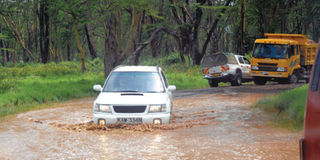Floods threaten tourism at Nakuru park

A tourist vehicle is driven through a flooded section of a road at the shores of Lake Nakuru within Nakuru National Park at the weekend. Water levels have risen by more than three metres due to heavy rains pounding regions where rivers that feed the lake originate. Photo |
What you need to know:
- For the last six months, the number of flamingos has been reducing due to increasing levels of the water — a situation that has been attributed to heavy rains in the region.
- The raging waters have submerged the pink carpets’ habitat, leading to their migration.
- Most of the roads leading to the park are also flooded. One of the roads, which leads to baboon cliff, a major tourist attraction, has been closed.
Flamingos, the main attraction at Lake Nakuru National Park, have fled due to floods in the habitat, threatening to cripple local tourism.
Roads leading to the park have also been submerged, making it impossible for visitors to get to the shores of the lake.
For the last six months, the number of flamingos has been reducing due to increasing levels of the water — a situation that has been attributed to heavy rains in the region.
The raging waters have submerged the pink carpets’ habitat, leading to their migration.
According to the park’s deputy senior warden, Mr Joseph Dadacha, water levels in the lake have risen to occupy 46 square kilometres from the normal 40 square kilometres.
He said the lake had experienced the highest water levels since 1979. Heavy rains are pounding areas where rivers that feed the lake originate. Most the rivers originate from Mau Forest Complex.
“A census conducted three weeks ago indicates that the number of flamingos has reduced to approximately 10,000 from 1.7 million before the onset of rains,” Mr Dadacha told the Nation at the weekend.
The decrease has also been attributed to reduction in algae — the main food for flamingos. Algae thrives in highly salty waters but the increased inflow of fresh water has diluted the lake’s salt levels.
Most of the roads leading to the park are also flooded. One of the roads, which leads to baboon cliff, a major tourist attraction, has been closed.
The floods have blocked the main gate to the park and some visitors heading to hotels are using the Nderit and Lanet gates.
Half-way submerged
“I could not use the main gate, again. My vehicle was half-way submerged in the water,” said a driver of one of the hotels.
The Kenya Wildlife Service has embarked on raising the levels of other roads leading to various points of the park to ensure they are not submerged.
In some areas, tourist vehicles are halfway under water and most of them stop far from the shores of the lake. Consequently, visitors can only see only a few of pelicans.
The current shoreline is also an eyesore characterised by litter, including plastic bottles, bags and rubber products from Nakuru town. The wet conditions have also seen tens of acacia trees, which surround the lake, dying.
Acacia, according to Mr Dadacha, does well in fairly dry areas and the soggy conditions have caused their roots to rot, leading to their fall.
However, all is not gloom because the floods have not interfered with tourist arrivals, according to Sarova Lion Hill manager Henry Nzioka.
“Guests have somehow been arriving without any cancellation. The only problem is that they cannot view flamingoes as clearly as they used to,” he said.
The rising water levels have also led to an increase in pastures in the lake. The adequate pasture has attracted different species of herbivores around the lake.
Buffalos and white rhinos are common sights as they cool their body temperatures in the flood waters.




